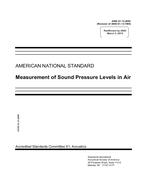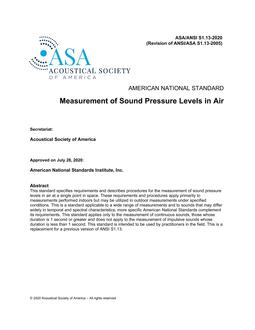
ASA S1.13-2005 (R2010)
- Comments Off on ASA S1.13-2005 (R2010)
- ASA
Click here to purchase
This standard specifies requirements and procedures for the measurement of sound pressure levels in air. These requirements and procedures apply primarily to measurements performed under normal, relatively quiescent meteorological conditions. Nearly all measurements made indoors will fall under such conditions, but outdoor measurements may also be made, and may remain in conformance with this standard provided the ranges of certain environmental variables are restricted, as described herein.
The requirements in this standard (identified by the use of the word shall) are to be understood as conditions on the measurements that must be met in order to state that such measurements have been made in conformance with this American National Standard. The guidelines and recommendations (identified by the use of the word should) are to be understood as conditions that will generally improve the accuracy, validity, applicability, documentation, and reporting of the measurement data but that are not mandatory for conformance. The type of sounds considered by this standard may differ widely in temporal and spectral characteristics. The sound to be measured may be continuous or intermittent; it may be steady, fluctuating, or impulsive; and it may be essentially broad band or contain discrete tones or narrow bands of noise.
The frequency range covered by the requirements of this standard depends on the specific type of sound level meter or instrumentation being used, but, in general, the frequency content of the sound being measured should be contained within the range covered by the octave bands having center frequencies from 31.5 Hz to 16.0 kHz. The sound pressure levels of sounds whose energy is concentrated outside of this range may not be measured accurately according to the procedures of this standard.
The sound pressure level descriptors primarily used in this standard are the time-average A-weighted sound level (also called the equivalent-continuous A-weighted sound pressure level) and the A-weighted sound exposure level. The choice of descriptor and the measurement procedures to follow depend on the type of sound, and this standard gives requirements and guidelines governing this choice.
The nature of the sound that is being measured by the procedures of this standard may be considered as either desirable (e.g., music from a symphony orchestra or a signal from an alarm device) or undesirable (e.g., noise from a busy highway or household vacuum cleaner). There is no differentiation as far as the procedures in this standard are concerned. This standard does not address the measurement of sound pressure levels in environments other than air (such as other gases, liquids, or solids), the measurement of infrasonic or ultrasonic sounds, or (generally) the measurement of sound pressure levels outdoors in nonquiescent conditions.
Purpose: This standard has a number of purposes, equally important. They are as follows:
a) To establish uniform procedures for measuring the sound pressure level in air at a single point in space.
b) To provide a classification of the types of sounds that can occur.
c) To facilitate the drafting of test codes, regulations, and the like by standardizing the basic requirements of sound pressure level measurements common to most of these documents. Rather than reiterating these requirements, the test codes and similar documents may simply refer to ANSI S1.13-2005 for the essential requirements.
d) To help make the procedures of acoustical measurements more accessible to regulatory personnel and the general public through clearly defining the steps and types of instrumentation necessary.
Product Details
- Published:
- 07/25/2005
- ANSI:
- ANSI Approved
- Number of Pages:
- 52
- File Size:
- 1 file , 320 KB



